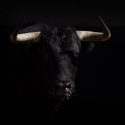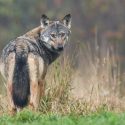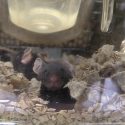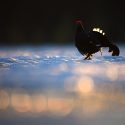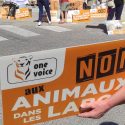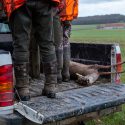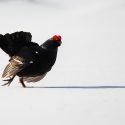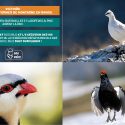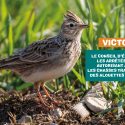More than 130 animal defence associations, including One Voice, support the bill for the abolition of bullfighting by Aymeric Caron. A national coordinated response is happening in more than forty towns.
Archives: News
One Voice will be at the Nîmes Administrative Tribunal on 15 November 2022 to save the Lozère and Haute-Loire wolves
One Voice’s emergency interim proceedings against the Lozère and Haute-Loire Prefectures to save the wolves will be heard on Tuesday 15 November 2022 at the Nîmes Administrative Tribunal.
Forced swimming: other approaches are possible
Forced swimming: other approaches are possible
Forced swimming: other approaches are possible
07.11.2022
Forced swimming: other approaches are possible
Animal testing
The Ministry of Research has approved electric shock and forced swimming procedures this year in France, while businesses worldwide are abandoning this largely criticised test that lobbies have trouble defending. Animals should not suffer for us, especially as substitution methods and non-experimental solutions exist to help people who are suffering.
The recent uses of the forced swimming test do not look to mimic human depression (something which this test does very badly), but to predict the efficacy of molecules on the depressive state. Despite quite poor recent data
in terms of the proportion of positive results for this prediction, we therefore cannot say that the forced swimming test is absolutely useless if it is carried out rigorously and with control of all of the variables that can influence the result. But the fact that a test using animals can be useful is not to say that it is justified.
Furthermore, as recently remarked by the NC3R (British centre mainly dedicated to alternatives for animal experimentation), effective molecules and pioneering routes could have been forgotten due to overconfidence in the results of this test.
In addition, other tests exist that are much less stressful for the animals, particularly in measuring their memory capacity to evaluate the effect of different molecules. But it is still the breeding of animals, caging them, and using them for our interests that is unacceptable.
Substitution methods
If we stick to ‘replacement’ as defined by French regulations, with the idea of aiming for the same short-term objectives and discovering the same experimental results without animals, the solutions are indeed very few but they exist and can be developed.
Cell culture research in this field does not allow us to estimate the behavioural effect of medications but is interesting in evaluating the biological effects which can be largely predictable concerning the efficacy of antidepressants. This is what was recently highlighted by the NC3R, by noting the predictive capacity already established in this field and the promising development of the amount of BDNF (brain-derived neurotrophic factor) in human blood and neuronal cell cultures.
From a technical standpoint, “computational psychiatry” is developed over several years, which will undoubtedly quickly make it possible to study many aspects of psychiatric diseases without hurting anyone.
But there may be better ways to measure: favouring prevention and putting favourable conditions in place for effective psychotherapy.
Prevention and non-medical treatments
When it comes to prevention, priority should be given to funding work on the external factors of depression and chronic stress in order to reduce the number of people affected by depression brought on by unfit working conditions or by exposure to a harmful social, political, and economic environment. Subsidies are not willingly extended. The money that funds forced swimming tests and the suffering inflicted on these animals is money that will not be used for working on the prevention of depression[1].
In addition, in a report from a very recent French documentary, Franck Ramus (a researcher in cognitive sciences) highlighted the link between the high use of psychoactive drugs in France and the superiority of the university curriculum for psychology by approaches based on beliefs rather than on proof, which had already been highlighted during a conference held in 2013 on this subject. The public therefore found themselves exposed to a majority of psychologists and psychiatrists who use unsuitable tools to treat them. Instead of funding the use of animals to develop medicine further, we can better use this money to embark upon an urgent reform of teaching psychotherapy and putting in place public information campaigns aiming to guide them towards effective treatments.
Animals must not suffer for us
Rats, these wonderful creatures full of empathy, who laugh, who play, who think, who feel emotions as complex as regret, do not have to suffer for us.
And what we can say for certain today is that the 600 rats who have been approved by the Ministry of Research to be used for repeated electric shock and forced swimming tests will suffer. This is happening in 2022, in France.
Join us in asking the Ministry of Research to ban these tests.
- Template (download here) to send via the Ministry’s form
- By sending tweets to the Ministry following the examples below:
On cruelty
Click on the text to tweet: Stop electric shocks and forced swimming for animals! Public powers should not authorise these cruel experiments @sup_recherche #StopForcedSwimming #EndAnimalTesting #AnimalTesting https://ctt.ec/_h2fq+ via @onevoiceanimal
Click on the text to tweet: .@sup_recherche, France must commit, like laboratories abroad, to put an end to cruel forced swimming tests on mice and rats!
#StopForcedSwimming #EndAnimalTesting #AnimalTesting https://ctt.ec/UPW92+ via @onevoiceanimal
On alternatives
Click on the text to tweet: Making rats depressed with electric shocks will not give more effective treatments. Stop #AnimalTesting, sup_recherche ! #StopForcedSwimming #EndAnimalTesting https://ctt.ec/iV6Un+ via @onevoiceanimal
Click on the text to tweet: Instead of torturing rats to produce yet more medications, train psychologists and psychiatrists with 21st century tools!
@sup_recherche #StopForcedSwimming #EndAnimalTesting #AnimalTesting https://ctt.ec/omBL7+ via @onevoiceanimal
Click on the text to tweet: Stop electric shocks and forced swimming! More funding for in vitro methods! @sup_recherche #StopForcedSwimming #EndAnimalTesting #AnimalTesting https://ctt.ec/c1dLo+ via @onevoiceanimal
[1] The reallocation of funds is not particularly simple and must be done on a political level for public funding, and by raising awareness of foundations and other organisations for private subsidies. But this reallocation seems largely necessary when we see the suffering that is generated by the current allocation of funding.
This article is the fourth in a series of five on forced swimming:
- Electric shocks and forced swimming in France in 2022
- Forced swimming: footage
- Forced swimming: the businesses moving forward and the industry that resists
- Forced swimming: other approaches are possible
- Forced swimming: a long-term battle (to come)
Translated from the French by Joely Justice
Urgent suspension of black grouse hunting in two out of three areas in the Hautes-Alpes!
Another victory for black grouse thanks to One Voice: in the Hautes-Alpes, the prefectural decree has been partially suspended.
Animal testing on the radio
Public radio has a tendency, in recent months, to only invite people who defend animal testing. With your help, we can hope that this situation changes.
One Voice is and always will be in favour of a true hunting reform!
The Secretary of State in charge of biodiversity is about to make an announcement on the safety of hunting after numerous accidents. One Voice is taking a stand.
One Voice will defend black grouse at the Marseille Administrative Tribunal on Monday 24 October 2022
The Hautes-Alpes Prefect has invoked a decree fixing the number of black grouse that can be hunted in the department. One Voice will be at the hearing at the Marseille Administrative Tribunal on 24 October 2022 to defend them.
The Muller Circus in Vallauris: illegal set-up, a dumping ground, animals kept in despicable conditions…
Whistle-blowers have returned to Vallauris where the Mayor has succeeded in evacuating the Muller Circus, where the animals live imprisoned among tarmac and rubbish…
Victory for mountain Galliformes: One Voice has had the Savoie Prefect’s decree suspended!
One Voice has just obtained an urgent suspension of the Savoie prefectural decree, thus sparing the lives of hundreds of black grouse, rock partridges, and rock ptarmigans.
Traditional hunting of larks: Victory! The State Council has urgently suspended the decrees
Traditional hunting of larks: Victory! The State Council has urgently suspended the decrees
Traditional hunting of larks: Victory! The State Council has urgently suspended the decrees
21.10.2022
Traditional hunting of larks: Victory! The State Council has urgently suspended the decrees
Hunting
One Voice and the LPO have defended the fate of larks that have been trapped and killed in the name of traditional hunting in the Gironde, Landes, Lot-et-Garonne, and Pyrénées-Atlantiques Departments for the 2022-2023 hunting season. Our two associations filed emergency interim suspension proceedings on the Monday following the issue of the laws signed by the Ministry of the Ecological Transition. They defended birds tooth and nail before a ministry and hunters who did not know how to justify the pig-headedness of issuing new decrees that had scarcely been reformulated after the repeated cancellations and suspensions in preceding years.
There was an urgency to act and the State Council, consistent with past decisions, sided with our arguments. Field larks are on the list of birds classified on the IUCN Red List. And as the European Union Court of Justice recalled, France has not respected the European ‘Birds’ Directive of 30 November 2009 because it has contravened two exonerating criteria. On one hand, the absence of alternative techniques for trapping birds in particular, on the other, the fact that this technique allows the capture only of individuals of this species, in very limited numbers and without harm. The Ministry failed to demonstrate that the nets and cages were the only existing methods, that they only capture larks, or that they do not capture other bird species without killing any in the process…
The urgent applications judge at the State Council ruled that a “serious doubt” existed on the legality of the 2022 decrees challenged by One Voice and the LPO, and ordered them to be suspended immediately, from the day after the hearing.
«We come back here to the State Council each year, we would like this to be the last. And when I think about nature and the shared heritage of future generations, I have a dream, which should not be one, that the Ministry of Ecology will guarantee the protection of birds and biodiversity. And that their primary concern will not be to protect a hobby which is nothing other than that: a recreational hobby as we have heard during the hearing. Birds are disappearing and potentially there are cultural elements, but in that case, it should be the Ministry of Culture who must face us. Here it is about the Ministry of Ecology. It should be there to serve in protecting biodiversity.»Muriel Arnal, President of One Voice
When will the Ministry of Ecology stop delivering birds, whose species is disappearing through our own faults, to hunters, all while daring to talk about conservation and daring to say that they are worried about biodiversity? When will those who govern us respect the highest decisions of the administrative legal courts in France? After the cancellations of the 2018 to 2020 decrees and the suspension of the 2021 and 2022 ones, we hope that this time the Ministry of Ecology will give into it.
The hearing regarding the cancellation of the suspended decrees of 2021 is set for Monday 24 October; we will be there for the birds.
Translated from the French by Joely Justice
